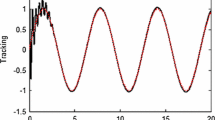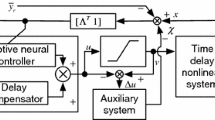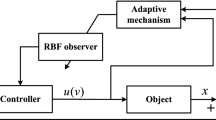Abstract
This paper proposes a novel adaptive control criterion for a class of single-input-single-output (SISO) uncertain nonlinear systems by using extended neural networks (ENNs). Distinguished from the traditional neural networks, our ENNs are composed of radial basis function neural networks (RBFNNs), scalers and saturators. And these ENNs are used to approximate the uncertainties in the nonlinear systems. Based on the Lyapunov stability theory and our ENNs, an adaptive control scheme is designed to guarantee that all the signals in the closed-loop system are uniformly ultimately bounded (UUB). It is also worth pointing out that our control method makes the construction of RBFNNs and the design of adaptive laws separated, which means only the outputs of ENNs and one update law of the parameter in the scaler are to be adjusted. Thus, our control scheme can effectively reduce the online computation burden of the adaptive parameters. Finally, simulation examples are given to verify the effectiveness of our theoretical result.
Similar content being viewed by others
References
S. Saat, S. K. Nguang, C. Lin, and Z. Zakaria, “Robust nonlinear H ∞ state feedback control of polynomial discretetime systems: an integrator approach,” Circuits, Systems, and Signal Processing, vol. 33, no. 2, pp. 331–346, February 2014. [click]
S. Saat and S. K. Nguang, “Nonlinear output feedback control with integrator for polynomial discrete-time systems,” International Journal of Robust and Nonlinear Control, vol. 25, no. 7, pp. 1051–1065, May 2015. [click]
J. Fernando, K. Godpromesse, and L. Francoise, “A novel online training neural network-based algorithm for wind speed estimation and adaptive control of PMSG wind turbine system for maximum,” Renewable. Energy, vol. 86, pp. 38–48, February 2016. [click]
B. Chen, H. Zhang, and C. Lin, “Observer-based adaptive neural network control for nonlinear systems in nonstrictfeedback form,” IEEE Trans. on Neural Networks and Learning Systems, vol. 27, no. 1, pp. 89–98, January 2016. [click]
A. Sahoo, H. Xu, and S. Jagannathan, “Adaptive neural network-based event-triggered control of single-input single-output nonlinear discrete-time systems,” IEEE Trans. on Neural Networks and Learning Systems, vol. 27, no. 1, pp. 151–164, January 2016. [click]
A. Sun, L. Lu, and C. Li, “Synchronization of an uncertain small-world neuronal network based on modified sliding mode control technique,” Nonlinear Dynamics, vol. 82, no. 4, pp. 1905–1912, December 2015.
W. Assawinchaichote, S. K. Nguang, and P. Shi, “Fuzzy control and filter design for uncertain fuzzy systems,” Springer, Lecture Notes in Control and Information Sciences, ISBN: 978-3-540-37011-6 (Print) 978-3-540-37012-3 (Online), 2006.
S. K. Nguang, W. Assawinchaichote, P. Shi, and Y. Shi, “Robust H ∞ control design for uncertain fuzzy systems with Markovian jumps: an LMI approach,” American Control Conference, pp. 1805–1810, 2005. [click]
W. Zeng and Q. Wang, “Learning from adaptive neural network control of an underactuated rigid spacecraft,” Neurocomputing, vol. 168, no. 30, pp. 690–697, November 2015. [click]
Y. Fang, J. Fei, and K. Ma, “Model reference adaptive sliding mode control using RBF neural network for active power filter,” International Journal of Electrical Power & Energy Systems, vol. 73, pp. 249–258, December 2015. [click]
Y. Zhang and S. Wang, “MLP technique baseed reinforcement learning control of discrete pure-feedback systems,” Neurocomputing, vol. 168, pp. 401–407, November 2015. [click]
J. Fei and H. Ding, “Adaptive sliding mode control of dynamic system using RBF neural network,” Nonlinear Dynamics, vol. 70, no. 2, pp. 1563–1573, October 2012. [click]
H. Wang, B. Chen, and C. Lin, “Direct adaptive neural control for strict-feedback stochastic nonlinear systems,” Nonlinear Dynamics, vol. 67, no. 4, pp. 2703–2718, March 2012.
L. Yu, S. Fei, J. Huang, and Y. Gao, “Trajectory switching control of robotic manipulators based on RBF neural networks,” Circuits, Systems, and Signal Processing, vol. 33, no. 4, pp. 1119–1133, April 2014. [click]
M. Wang, X. Liu, and P. Shi, “Adaptive neural control of pure-feedback nonlinear time-delay systems via dynamic surface technique,” IEEE Trans. on Systems, Man, and Cybernetics, Part B (Cybernetics), vol. 41, no. 6, pp. 1681–1692, December 2011. [click]
H. Jafarnejadsani, J. Pieper, and J. Ehlers, “Adaptive control of a variable-speed variable-pitch wind turbine using radial-basis function neural network,” IEEE Trans. on Control Systems Technology, vol. 21, no. 6, pp. 2264–2272, November 2013. [click]
Q. Zhu, S. Fei, T. Zhang, and T. Li, “Adaptive RBF neuralnetworks control for a class of time-delay nonlinear systems,” Neurocomputing, vol. 71, no. 16-18, pp. 3617–3624, October 2008.
M. Pai, “Dynamic output feedback RBF neural network sliding mode control for robust tracking and model following,” Nonlinear Dynamics, vol. 79, no. 2, pp. 1023–1033, January 2015. [click]
Y. Pan, T. Sun, and H. Yu, “Peaking-free output-feedback adaptive neural control under a nonseparation principle,” IEEE Trans. on Neural Networks and Learning Systems, vol. 26, no. 12, pp. 3097–3108, December 2015. [click]
N. T. Tai and K. K. Ahn, “A RBF neural network sliding mode controller for SMA actuator,” International Journal of Control, Automation and Systems, vol. 8, no. 6, pp. 1296–1305, December 2010.
J. Platt, “A resource-allocating network for function interpolation,” Neural Computation, vol. 3, no. 2, pp. 213–225, June 1991. [click]
Y. Lu, N. Sundararajan, and P. Saratchandran, “A sequential learning scheme for function approximation using minimal radial basis function neural networks,” Neural Computation, vol. 9, no. 2, pp. 461–478, February 1997. [click]
H. Feng, “Self-generation RBFNs using evolutional PSO learning,” Neurocomputing, vol. 70, no. 1-3, pp. 241–251, December 2006. [click]
S. Chen, X. Hong, B. L. Luk, and C. J. Harris, “Construction of tunable radial basis function networks using orthogonal forward selection,” IEEE Trans. on Systems, Man, and Cybernetics, Part B (Cybernetics), vol. 39, no. 2, pp. 457–466, April 2009. [click]
D. Du, K. Li, and M. Fei, “A fast multi-output RBF neural network construction method,” Neurocomputing, vol. 73, no. 10-12, pp. 2196–2202, June 2010. [click]
D. Shi, D. S. Yeung, and J. Gao, “Sensitivity analysis applied to the construction of radial basis function networks,” Neural Networks, vol. 18, no. 7, pp. 951–957, September 2005. [click]
Y. Wang, L. Luo, Y. Fan, Y. Zhang, X. Liu, and S. Zhang, “Adaptive control design for a class of nonlinear systems based on fuzzy logic systems with scalers and saturators,” International Journal of Systems Science, vol. 45, no. 3, pp. 202–214, March 2014. [click]
S. X. Ng, M. Yee, and L. Hanzo, “Coded modulation assisted radial basis function aided turbo equalization for dispersive Rayleigh-fading channels,” IEEE Trans. on Wireless Communications, vol. 3, no. 6, pp. 2198–2206, November 2004. [click]
J. Gonzalez, I. Rojas, J. Ortega, H. Pomares, F. J. Fernandez, and A. F. Diaz, “Multiobjective evolutionary optimization of the size, shape, and position parameters of radial basis function networks for function approximation,” IEEE Trans. on Neural Networks, vol. 14, no. 6, pp. 1478–1495, November 2003. [click]
X. Hong, S. Chen, and C. J. Harris, “A fast linear-in-theparameters classifier construction algorithm using orthogonal forward selection to minimize leave-one-out misclassification rate,” International Journal of Systems Science, vol. 39, no. 2, pp. 119–125, February 2008. [click]
J. E. Slotine, Applied Nonlinear Control, Prentice Hall, Englewood Cliffs, NJ., 1991.
Y. Wei, J. Qiu, P. Shi, and H. Lam, “A new design of Hinfinity piecewise filtering for discrete-time nonlinear timevarying delay systems via T-S fuzzy affine models,” IEEE Trans. on Systems, Man, and Cybernetics: Systems, vol. 47, no. 8, pp. 2034–2047, August 2017. [click]
Y. Wei, J. Qiu, H. Lam, and L. Wu, “Approaches to T-S fuzzy-affine-model-based reliable output feedback control for nonlinear itô stochastic systems,” IEEE Trans. on Fuzzy Systems, vol. 25, no. 3, pp. 569–583, June 2017. [click]
Y. Wei, J. Qiu, and H. R. Karimi, “Reliable output feedback control of discrete-time fuzzy affine systems with actuator faults,” IEEE Trans. on Circuits and Systems I: Regular Papers, vol. 64, no. 1, pp. 170–181, January 2017. [click]
M. Chemachema, “Output feedback direct adaptive neural network control for uncertain SISO nonlinear systems using a fuzzy estimator of the control error,” Neural Networks, vol. 36, pp. 25–34, December 2012. [click]
C. Wang, H. Liu, and T. Lin, “Direct adaptive fuzzy-neural control with state observer and supervisory controller for unknown nonlinear dynamical systems,” IEEE Trans. on Fuzzy Systems, vol. 10, no. 1, pp. 39–49, February 2002. [click]
M. Wang, C. Wang, and X. Liu, “Dynamic learning from adaptive neural control with predefined performance for a class of nonlinear systems,” Information Sciences, vol. 279, pp. 874–888, September 2014. [click]
Y. Wei, J. Qiu, H. R. Karimi, and M. Wang, “Filtering design for two-dimensional Markovian jump systems with state-delays and deficient mode information,” Information Sciences, vol. 269, pp. 316–331, June 2014. [click]
Y. Wei, J. Qiu, H. R. Karimi, and M. Wang, “New results on H ∞ dynamic output feedback control for Markovian jump systems with time-varying delay and defective mode information,” Optimal Control Applications And Methods, vol. 35, pp. 656–675, November 2014. [click]
Author information
Authors and Affiliations
Corresponding author
Additional information
Recommended by Associate Editor Sing Kiong Nguang Editor Hamid Reza Karimi. This work was supported by the National Natural Science Foundation of China (61273219, 61673120, 61603098), the Natural Science Foundation of Guangdong Province of China (2016A030310336) and Specialized Research Fund for the Doctoral Program of Higher Education of China (20134420110003).
Hao-guang Chen is currently working toward a Ph.D. degree in the School of Automation, Guangdong University of Technology, Guangzhou, P. R. China. His research interests include nonlinear dynamical systems, neural network, fuzzy logic systems and adaptive control.
Yin-he Wang received his M. S. degree in mathematics from Sichuan Normal University, Chengdu, P. R. China, in 1990, and the Ph.D. degree in control theory and engineering from Northeastern University, Shenyang, P. R. China, in 1999. From 2000 to 2002, he was a Post-doctor in Department of Automatic control, Northwestern Polytechnic University, Xi’an, P. R. China. From 2005 to 2006, he was a visiting scholar at Department of Electrical Engineering, Lakehead University, Canada. He is currently a Professor with the Faculty of Automation, Guangdong University of Technology, Guangzhou, China. His research interests include fuzzy adaptive robust control, analysis for nonlinear systems and complex dynamical networks.
Li-li Zhang received the M.S. degree in applied mathematics from University of Science and Technology Beijing, Beijing, P. R. China, in 2004, and the Ph.D. degree in school of automation, Guangdong University of Technology, Guangzhou, China, in 2014. She is currently an associate professor in School of Applied Mathematics, Guangdong University of Technology, Guangzhou, China. Her research interests include control and synchronization for complex dynamical networks and chaotic systems.
Rights and permissions
About this article
Cite this article
Chen, Hg., Wang, Yh. & Zhang, Ll. Adaptive Control based on Extended Neural Network for SISO Uncertain Nonlinear Systems. Int. J. Control Autom. Syst. 16, 27–38 (2018). https://doi.org/10.1007/s12555-016-0721-3
Received:
Revised:
Accepted:
Published:
Issue Date:
DOI: https://doi.org/10.1007/s12555-016-0721-3




